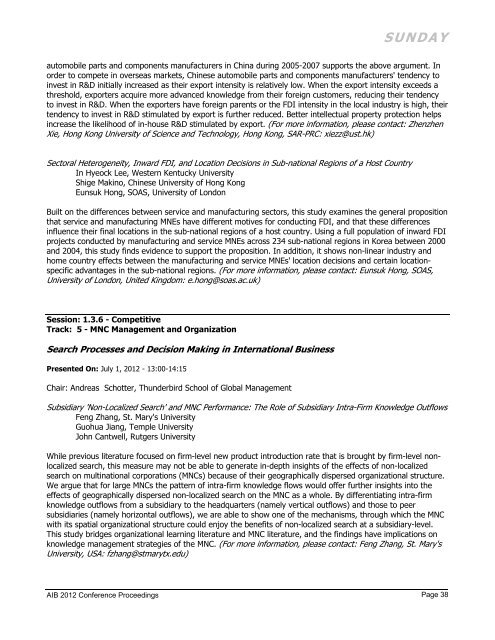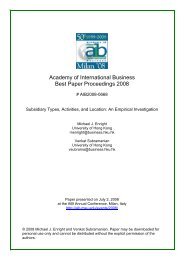AIB 2012 Conference Proceedings - Academy of International ...
AIB 2012 Conference Proceedings - Academy of International ...
AIB 2012 Conference Proceedings - Academy of International ...
You also want an ePaper? Increase the reach of your titles
YUMPU automatically turns print PDFs into web optimized ePapers that Google loves.
SUNDAY<br />
automobile parts and components manufacturers in China during 2005-2007 supports the above argument. In<br />
order to compete in overseas markets, Chinese automobile parts and components manufacturers' tendency to<br />
invest in R&D initially increased as their export intensity is relatively low. When the export intensity exceeds a<br />
threshold, exporters acquire more advanced knowledge from their foreign customers, reducing their tendency<br />
to invest in R&D. When the exporters have foreign parents or the FDI intensity in the local industry is high, their<br />
tendency to invest in R&D stimulated by export is further reduced. Better intellectual property protection helps<br />
increase the likelihood <strong>of</strong> in-house R&D stimulated by export. (For more information, please contact: Zhenzhen<br />
Xie, Hong Kong University <strong>of</strong> Science and Technology, Hong Kong, SAR-PRC: xiezz@ust.hk)<br />
Sectoral Heterogeneity, Inward FDI, and Location Decisions in Sub-national Regions <strong>of</strong> a Host Country<br />
In Hyeock Lee, Western Kentucky University<br />
Shige Makino, Chinese University <strong>of</strong> Hong Kong<br />
Eunsuk Hong, SOAS, University <strong>of</strong> London<br />
Built on the differences between service and manufacturing sectors, this study examines the general proposition<br />
that service and manufacturing MNEs have different motives for conducting FDI, and that these differences<br />
influence their final locations in the sub-national regions <strong>of</strong> a host country. Using a full population <strong>of</strong> inward FDI<br />
projects conducted by manufacturing and service MNEs across 234 sub-national regions in Korea between 2000<br />
and 2004, this study finds evidence to support the proposition. In addition, it shows non-linear industry and<br />
home country effects between the manufacturing and service MNEs' location decisions and certain locationspecific<br />
advantages in the sub-national regions. (For more information, please contact: Eunsuk Hong, SOAS,<br />
University <strong>of</strong> London, United Kingdom: e.hong@soas.ac.uk)<br />
Session: 1.3.6 - Competitive<br />
Track: 5 - MNC Management and Organization<br />
Search Processes and Decision Making in <strong>International</strong> Business<br />
Presented On: July 1, <strong>2012</strong> - 13:00-14:15<br />
Chair: Andreas Schotter, Thunderbird School <strong>of</strong> Global Management<br />
Subsidiary 'Non-Localized Search' and MNC Performance: The Role <strong>of</strong> Subsidiary Intra-Firm Knowledge Outflows<br />
Feng Zhang, St. Mary's University<br />
Guohua Jiang, Temple University<br />
John Cantwell, Rutgers University<br />
While previous literature focused on firm-level new product introduction rate that is brought by firm-level nonlocalized<br />
search, this measure may not be able to generate in-depth insights <strong>of</strong> the effects <strong>of</strong> non-localized<br />
search on multinational corporations (MNCs) because <strong>of</strong> their geographically dispersed organizational structure.<br />
We argue that for large MNCs the pattern <strong>of</strong> intra-firm knowledge flows would <strong>of</strong>fer further insights into the<br />
effects <strong>of</strong> geographically dispersed non-localized search on the MNC as a whole. By differentiating intra-firm<br />
knowledge outflows from a subsidiary to the headquarters (namely vertical outflows) and those to peer<br />
subsidiaries (namely horizontal outflows), we are able to show one <strong>of</strong> the mechanisms, through which the MNC<br />
with its spatial organizational structure could enjoy the benefits <strong>of</strong> non-localized search at a subsidiary-level.<br />
This study bridges organizational learning literature and MNC literature, and the findings have implications on<br />
knowledge management strategies <strong>of</strong> the MNC. (For more information, please contact: Feng Zhang, St. Mary's<br />
University, USA: fzhang@stmarytx.edu)<br />
<strong>AIB</strong> <strong>2012</strong> <strong>Conference</strong> <strong>Proceedings</strong><br />
Page 38

















